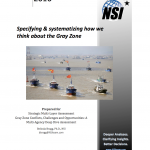Specifying and Systematizing the Gray Zone
Specifying & systematizing how we think about the Gray Zone.
Author | Editor: Bragg, B. (NSI, Inc).
In their continued work on the changing nature of the threat environment General Votel et al forecast that the majority of threats to US security interests in coming years will be found in a ‘gray zone’ between acceptable competition and open warfare. They define the gray zone as ‘characterized by intense political, economic, informational, and military competition more fervent in nature than normal steady-state diplomacy, yet short of conventional war.’ While this characterization is a useful guide, it is general enough that efforts by planners, scholars and analysts to add the level of specificity needed for their tasks can generated considerable variation in how the term is applied, and to which types of actions and settings it applies.
What lies between acceptable competition and conventional war?
Far from an unnecessarily academic or irrelevant question, this is a critical question. How we define a condition or action, in other words the frame through which we are categorizing certain actions as threatening rather than “normal steady-state” impacts what we choose to do about them. The “I know it when I see it” case-by-case determination of gray vs not gray limits identification of gray zone actions to those that have already occurred. Gaining some clarity on the nature of a gray zone challenges is essential for effective security coordination and planning, development of indicators and warning measures, assessments of necessary capabilities and authorities and development of effective deterrent strategies.
The ambiguous nature of the gray zone and the complex and fluid international environment of which it is a part, make it unlikely that there will be unanimous agreement about its definition. Our first goal in this paper then, is to describe the gray zone as much as define it. We begin with a review the work of a number of authors who have written on the nature and characteristics of gray zone challenges, and use these to identify areas of consensus regarding the characteristics of the gray space between steady-state competition and open warfare. We next use these to suggest a more systematic process for characterizing different shades of gray zone challenges.

Comments